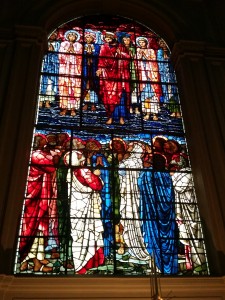SIGHT (Birmingham Museum and Art Gallery): The BM&AG, as it is also known, opened in 1885 and today houses a number of internationally renowned collections. Some of the most important are the collection of pre-Raphaelite paintings (19th century) and the Staffordshire Hoard, which was discovered in 2009 as the largest hoard of Anglo-Saxon gold ever found. The entrance building also houses the Birmingham City Council House, and so the main part of the museum’s collections are actually in the extension building (opened 1917) on the other side of Edmund Street. The buildings are connected by a footbridge. Entrance is free, but some special exhibitions may charge extra. Inside the museum is also the Edwardian Tea Room, which is worth a short visit, but which mostly serve standard fare café food and bottled international beers. We recommend that you take a quick walk inside the museum and the Tea Room to get an idea of what is there, but if you really want to see the collections, you should set aside half a day to do so some other time and skip it for now.
PINT (The Old Joint Stock): Walk on the right side of the BM&AG building along Victoria Square and continue up Colmore Row making a right turn when you reach Cathedral Square. You are now in front of The Old Joint Stock, a beautiful pub with high ceilings based in an 1864 building originally designed for the Birmingham Joint Stock Bank. It was converted into a pub in 1997, and is supposedly the northernmost Fuller-pub in the UK. The Old Joint Stock Pub has a nice selection of food and ales, and if you’re hungry by now do have a bite to eat. If not that hungry, wait for about 40 minutes until you reach The Old Contemptibles (more about this later).
SIGHT (Birmingham Cathedral): St. Philip’s Cathedral just opposite The Old Joint Stock Pub is probably one of the smallest cathedrals you’ll ever see in a city this size, it being the third smallest cathedral in England. Consecrated as a parish church in 1715, it became the cathedral of the newly formed Diocese of Birmingham in 1905. The cathedral suffered heavy damage to German bombers on November 7, 1940. Fortunately, the cathedral’s great treasure, a number of windows designed by Pre-Raphaelite artist Edward Burne-Jones in the 1890s, had been removed in the early stages of the war, and were replaced, unharmed, when the building was restored in 1948.
In the churchyard is a number of memorials, including one to the victims of the 1974 Birmingham pub bombings. On November 21 of that year, bombs placed by the Provisional IRA razed city pubs Mulberry Bush in the Rotunda and the Tavern in the Town on New Street. 21 people lost theirs lives and 182 were injured in what was the worst terrorist attack on UK soil until the July 7 bombings in London in 2005. The premises on 134D New Street occupied by the Tavern in the Town housed a pub until 2010, but is now a cheap and not very good Buffet Hut restaurant. Mulberry Bush was reopened as Bar St. Martins, but is now a tourist centre.
OPTIONAL FOOD (Habaneros): One of the best street food vendors in Birmingham sits just outside the churchyard railings on week days. It is a Mexican Street Food van named Habaneros, offering a range of tacos, burritos and five different kinds of salsa. If you are hungry, and your think your stomach and taste buds are up for it, try their Super Hot Habanero XXX salsa, which is only available upon special request. Good luck and remember that beer is not necessarily the best beverage for easing this kind of pain.


